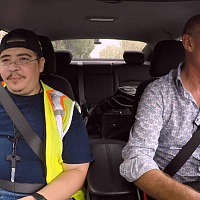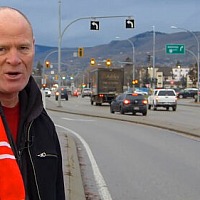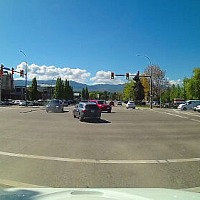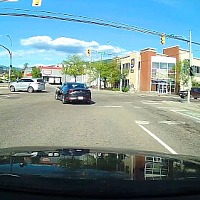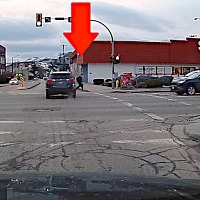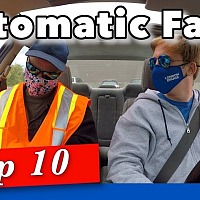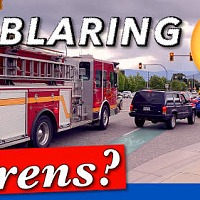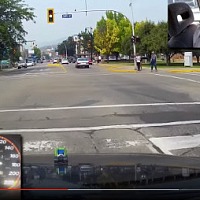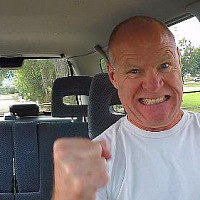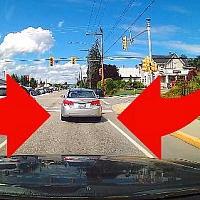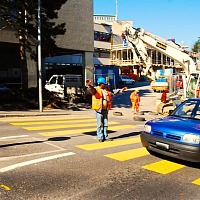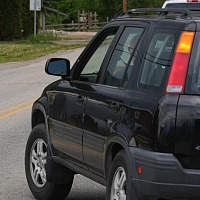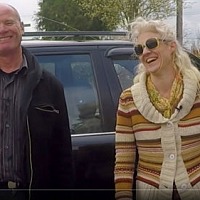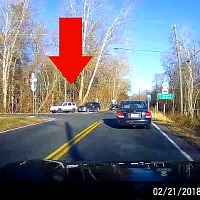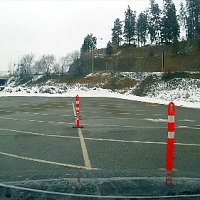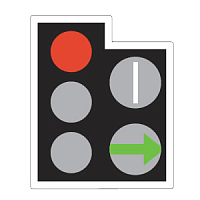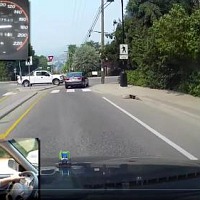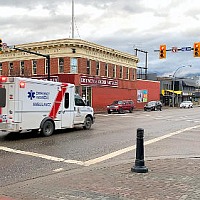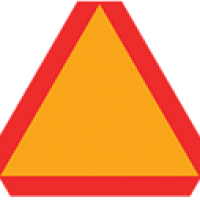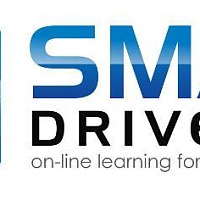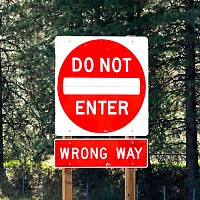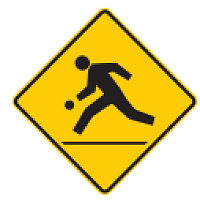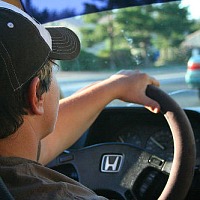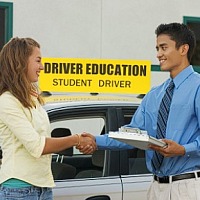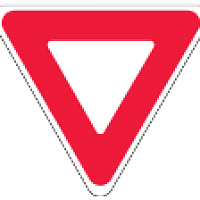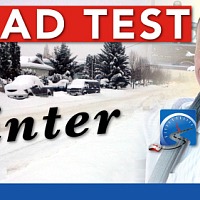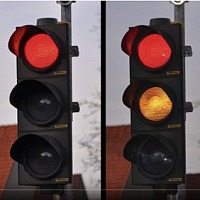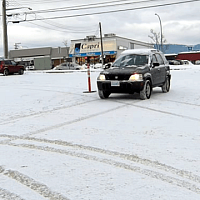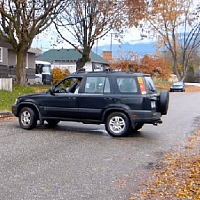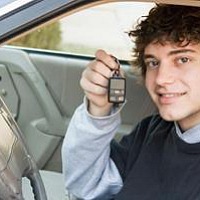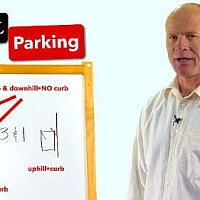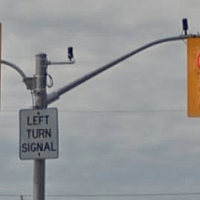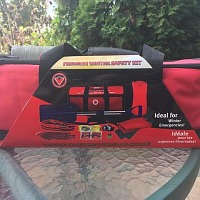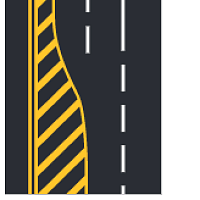To pass a road test, turning left at complex intersections is a must-have skill - watch the video.
https://www.youtube.com/embed/QQskdDGE6LY
How to Turn Left | Complex Intersections to Pass a Road Test
Closed Caption
Steps for Turning Left at an Intersection1) Locate the turn: is it legal? 2) Check centre mirror to ensure it's safe to slow. Shoulder check, and activate left signal approximately 1/2 block from turn; 3) Scan the intersection ahead for traffic controls (signs, lights, road markings) and road users; 4) Move completely into left turning lane as soon as it starts; 5) Stop at the correct stopping position (STOP line or behind traffic so you can see tires of car in front making clear contact with pavement); 6) If you're the last vehicle in line, continue to scan traffic to rear; 7) When traffic light changes to green, move up so front steer tires are on front crosswalk line; 8) When traffic gap appears move forward into the intersection to meet gap. Start turning when you are in line with edge of road; 9) Check mirror and shoulder check immediately before turning. Watch cross-street for pedestrians crossing; 10) Turn into the left lane; 11) Speed for left turn should be 12-20mph (20-30kph) depending on size of intersection; 12) When vehicle straightens after completing turn, change lanes back to right lane. |
Hi there smart drivers, Rick with Smart Drive Test.
A reshoot of how to turn left.
I had comments a comment from LeStatisticien and lydia2010tion - both commented that they couldn't see the intersection, so I've got a new camera for you today, and I've implemented a couple of editing techniques and hopefully all of this is going to be better.
I'd be very interested to hear your comments about how effective this is because I've implemented the tips that both LeStatisticien and lydia2010tion both left for me on the channel there and thus the reason for reshooting the left-hand turn.
I've got the camera hooked up and got my new dashcam, and we're going to go up and we're going to do that for you.
Stick around, we'll be right back with that information.
[OPENING CREDITS & MUSIC]
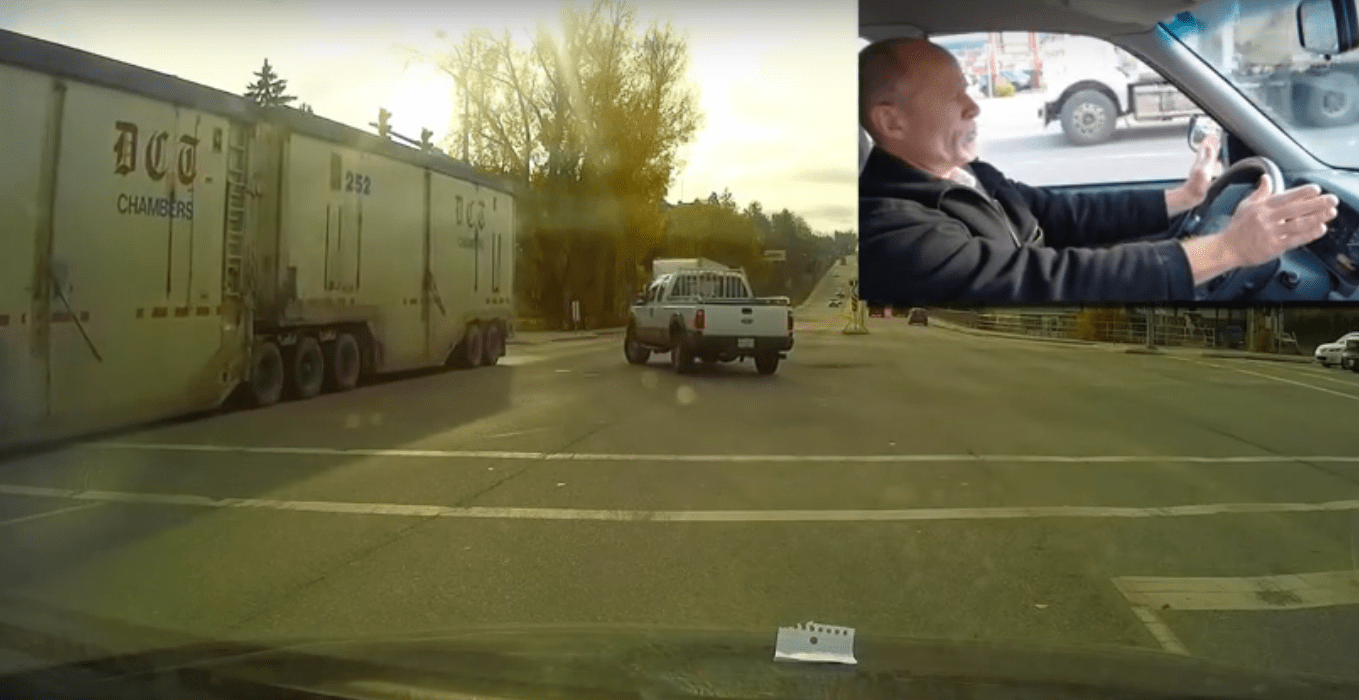 Hi there smart drivers - welcome back.
Hi there smart drivers - welcome back.
Rick with Smart Drive Test reshooting left-hand turns.
How to do a left-hand turn and I had a comment from LeStatisticien and lydia2010tion; and one of the comments was to be able to see the hood.
So the white marker is the middle of the hood on my vehicle.
I stuck a piece of paper on the hood which will give you an indication of where we're turning when turning left.
As well, I focused the dashcam mostly to the left so that you can see the left side of the intersection.
Most of the time there isn't a great deal of information that you need on the right-hand side of the intersection, so I haven't put the focus of a camera over to the right-hand side; the focus of the camera is to the left side of the intersection and I'll go through that with you as we're making left-hand turns.
Left Turn
So completely into the turning lane as soon as the turning lane starts.
The light is green.
There's a huge truck, as you can see, we stop with the front tires on the front crosswalk line.
Now the other thing I'm going to need to do is I'm going to do to do a little jig job here.
So I moved out to the left and then I straightened my wheels out again.
If I'm rear-ended from the rear...shoulder check - into the inside lane.
Immediately put on my right hand signal.
I don't want to change lanes over the railway crossing, until I come over the railway crossing, then I change lanes back to the right immediately when I make a left hand turn.
Jig-Jog So That You Can See
Now as I was saying there, you saw that in the video that I had to do that little jig-jog there to get...
I do that little jog there so that I could see past the truck that was blocking my view.
And again you want to bring the vehicle back to straight because if you are rear-ended from the rear you're not going to be driven out into the oncoming traffic.
Rather you're going to be pushed straightforward.
So instead of having two crashes, you're only going to have one crash from the rear.
And that is one of the dangers of turning left is that you could potentially be rear-ended and pushed out into oncoming traffic, which is especially dangerous if it you have passengers in the vehicle because the vehicle is going to strike the passenger side of the vehicle.
And it is unlikely your passengers going to live, especially if you're on a highway at high speeds.
But always, always when you're turning left and waiting to turn left keep your wheels straight...
Left Turn #2
Proceeding to go and we have a pedestrian on the left-hand side.
We're going to wait for him.
We have the advanced green & we have one lane between the pedestrians and ourselves.
We shoulder check and we proceed.
And we have our right hand signal on immediately.
Shoulder checking twice; I have my signal on and I'm leaving my signal on all the way across into the other lane.
I cancel my signal.
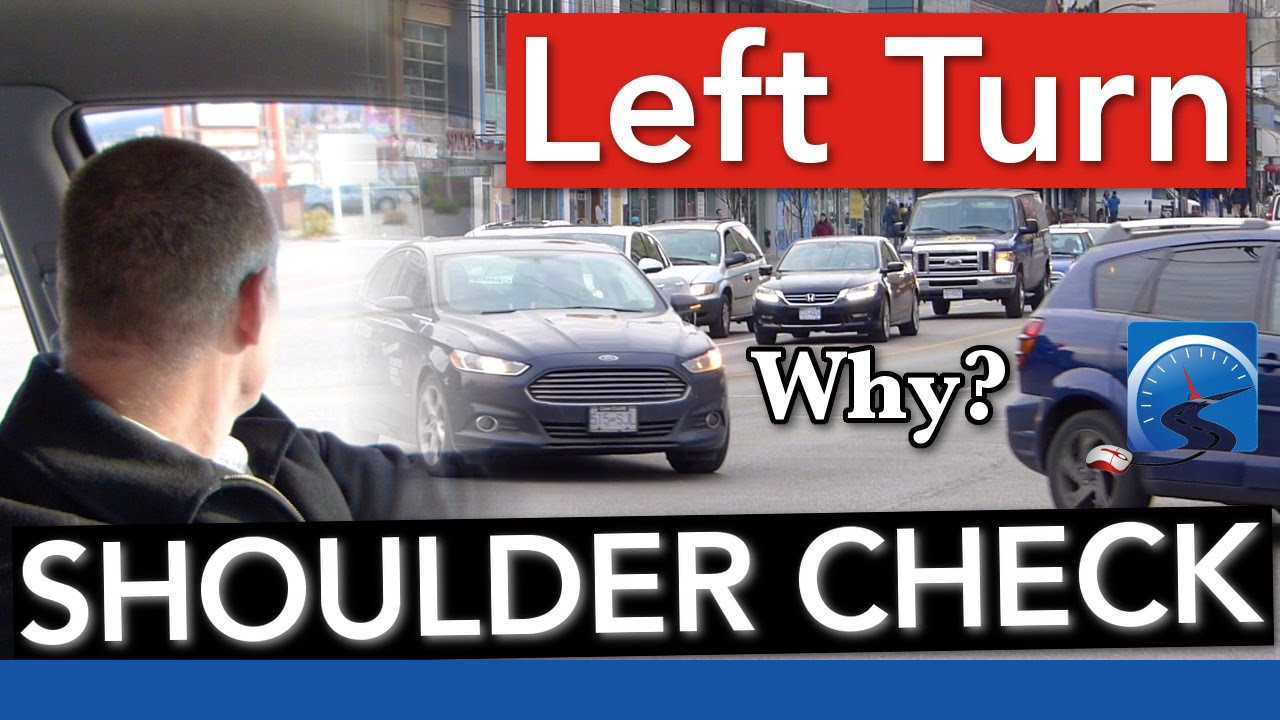
And as I moving diagonally across on the lane merge, I'm also speeding up a little bit to compensate for the increased distance that I'm moving on that bit of an angle.
Okay, so the traffic in my lane is braking and stopped.
We're proceeding through the intersection and it is clear.
I've got my left signal on.
I'm shoulder checking...
there's a vehicle behind me in the mirror.
And this vehicle in front of me is slowing down because of the red lights.
So I'm letting off the throttle a little bit.
I'm just working the throttle.
I kept my signal on until I was completely in the lane and again we have a painted island here and we do not--like that vehicle in front of us--we do not want to drive over that painted island.
Don't Drive Over Painted Islands
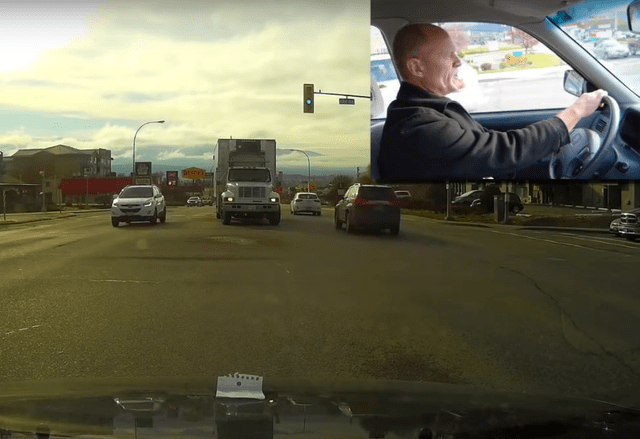 We want to wait until this vehicle in front of us proceeds forward, especially on a road test.
We want to wait until this vehicle in front of us proceeds forward, especially on a road test.
If you drive over that painted island you could potentially fail your road test or have major demerits which will cause you to fail your road test.
Never, never never, never, never drive over a painted island for the purposes of a road test.
Shoulder check into the turning lane.
Wait With Steer Tires on Front Crosswalk Line
And again we pull up so that the front steer tires are on the front crosswalk line.
More than 40% of crashes occur at intersections; therefore we don't want to be in the intersection in the event that something goes wrong. For example, somebody runs the red light. As we're waiting, we're watching for the gap. When the gap presents itself and approaches, we move forward into the intersection to meet the gap. If the gap doesn't present itself, we do the same when the light goes to yellow. However, when the light goes to yellow, check and triple check that the oncoming traffic is coming to a stop before proceeding. As we move forward to meet the gap we gain speed. With speed, you make your turn and minimize the time that you're in the path of cross traffic. This technique reduced the chances of being involved in a "T" bone crash. |
We're also checking for traffic coming up behind us because there isn't anybody behind us and we want to make sure that we don't get rear-ended so we're always checking that mirror.
Okay, the way is clear - shoulder check and I steer into the inside the left lane.
Okay I signal to the right, I shoulder check to the right, I start moving over and just before I moving into another lane I shoulder check again and I accelerate slightly.

I leave my signal on all the way until I'm in the other lane.
And I did actually shut my signal off just a touch early on that lane merge.
Okay, again I've got a red light, and I'm off throttle and checking the railway crossing.
The light has gone to green and I didn't have to brake because I saw the red light and I just let off the throttle and let the vehicle slow.
And I'm adjusting the space in front of my vehicle.
Now you can always, always control the space in front of your vehicle.
And I'll put a video up here for you - put a card up for you on controlling space in front of your vehicle for the purposes of defensive posturing.
I've got my left signal on approximately one half block from the turn.
Now on this intersection, it's a bit deceiving.
There are lane markings on the inside lane there, but there isn't a left-hand lane marking on this lane.
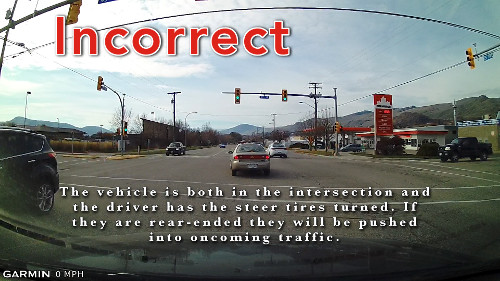
There is actually...you can see just a little bit of it there in front of me, but it is faded to the point of almost non-existence.
I live here and and I've done driver training here and I know that both lanes turn to the left.
When both lanes turn to the left you always want to be in - you want to be in the outside lane for the purpose of road test.
Because when you end up on the other side, you're going to end up in the right-hand lane.
Traffic is proceeding, shoulder check to the left, and look in the direction that I want to go.
I'm scanning the intersection and make sure nobody is coming even though we have the advanced green.
We steer in the direction we want to go and accelerate.
Two hands on the steering wheel.
As soon as that vehicle in front of me pulled over in front of me I just let off the throttle and and re-established my buffer of space in front of my vehicle again.
So that vehicle--you can see is tailgating the van in front of them--and for me I just let off the throttle and I just re-established my buffer of space in front of my vehicle once again.
Shoulder checking into the left turning lane.

Waiting in Traffic
I'm pulling up so that I can see the tires of the vehicle in front of me making clear contact with the roadway which is right about there.
Back into my starting gear.
And we're stopped waiting because the light turned red.
Two vehicles went through on the yellow and we're going to go on the advanced green.
There's a pedestrian approaching over on the far side and I am watching that pedestrian to see whether he comes across the slip lane, which he has crossed the slip lane.
Now I'm just gonna watch that pedestrian as I'm coming across.
Okay I've got the right of way and I steer into the inside lane.
The pedestrian's good - he's stayed on the island.
I put my right signal immediately.
The car behind me has moved over too, but he's allowed me space because I had my signal on.
Lane Merging
Now I'm going to turn right here and I've got my own lane.
I want to shoulder check because there's a bicycle lane there.
There's nobody coming and I accelerate into my own lane and steer at the direction of travel.
Signal to the left, shoulder check, check my mirror - moving to the left and I shoulder check immediately before I enter the other lane.
All the way into the other lane I leave my signal on.
Left signal, shoulder check, and move into the left-hand turning lane immediately.
The light is green, so I'm going to pull up so the front steer tires are on the front crosswalk line.
Okay, I've got a gap here.
I'm watching the green, in behind the red car which is driving incredibly slowly.
Left turn, steering in the direction I want to go.
And Looking - I'm checking the slip lane and accelerating up to speed.
Signal on - clear to go.
Steering through the intersection.
Looking in the path of travel - looking up.
Correct Stopping Position
Stopping at the stop line - just as the line disappears under the front of the vehicle - that's when you come to stop.
I can't see so I'm going to move forward, stop and check the intersection.
No pedestrians A truck is coming - lots of traffic to the left.
Not clear...
car coming from the right.
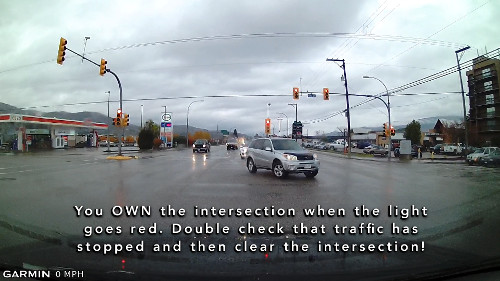
The car is turning, and we proceed.
Shoulder checking as we're moving through the intersection.
Continuing to scan.
Okay, so it's a red light so I'm not accelerating towards the red light.
I'm just letting off the throttle and the light turns to green and we move through the intersection.
And I scan the intersection: left, centre, right, and left again.
Because that's where the traffic is first coming from.
And I'm off the throttle again because the crosswalk is activated.
And I stopped to recreate my buffer of space in front of my vehicle.
And again I stopped back so I'm not in the intersection.
And I can see the tires making clear contact with the pavement.
I'm scanning the intersection: left, centre, right and left again.
Into the left turning lane.
And I can't see, so I'm going to sneak out and do my little zigzag.
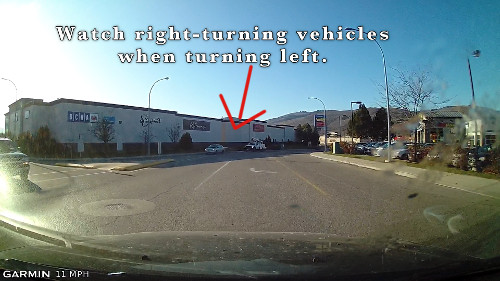
And it's clear.
And I'm gonna stay in this lane.
in the left hand lane because I'm going to turn left again up at the next intersection.
Posted Speed Limit Or Flow of Traffic - Lesser of the Two
And I'm doing about 42 kilometers an hour.
Unfortunately the dashcam player--the video player--only works on Windows to show the speed.
I did buy the GPS for the dashcam and I wanted to show you the speed.
Unfortunately it only works on Windows and I'm a Macintosh person.
Okay, the light is green and we have a gap.
I'm going to pull up so the front tires are on the front crosswalk line.
I've got my left signal on and I'm preparing to go.
I'm meeting the gap.
Shoulder check into the left-hand lane.
As soon as my vehicle straightens out, I put my right signal on.
Shoulder check to the right.
Shoulder check again just before I cross the line.
And I leave my signal on all the way into the other lane.
Right into the turning lane immediately.
Shoulder checking - the light is green so I'm going to put the front steer tires on the front crosswalk line.
Steer Tires on Front Crosswalk Line
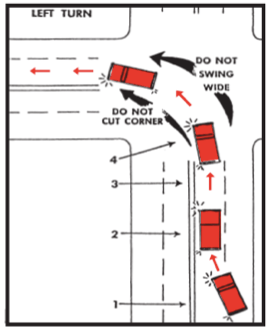 That way I...and the light has gone yellow, traffic is stopping and I clear the intersection.
That way I...and the light has gone yellow, traffic is stopping and I clear the intersection.
You'll have to watch that on your road test, that light goes to yellow that you have to clear that intersection immediately.
Okay, nobody coming on the railway crossing, nobody coming in front of me.
I change gears before reaching the intersection.
Shoulder check, left-hand turn.
Shoulder checking, and moving immediately into the left hand lane.
And you can see the overhead lane markings.
Stopping...the stop line just rolls under the front of the vehicle.
And I've got a pedestrian standing here on the left.
You can't see the pedestrian because the pedestrian is out of the shot of the left-hand turning lane, but you'll see the pedestrian move across on the left side here.
And I have to wait until that pedestrian attains the curb on the other side of the road.
So by the time the traffic clears, that pedestrians should be more or less across the road.
Now on this intersection, because we've done this intersection a couple of times, we need to do the little jog because we've got a huge van on the other side.
In order to be able to see and to keep the vehicle straight so that in the event that we get rear-ended, we're not going to be driven into oncoming traffic going this way.
We're simply going to be driven forward.

The pedestrian is going forward.
I do my little zigzag so i can see here, and I bring my wheels back to straight.
And like I said, the pedestrian is going to obtain the curb before the traffic clears here.
I'm also keeping an eye on the traffic light so that it doesn't go to yellow.
And the traffic is clearing.
I meet the gap.
Shoulder check and proceed into my lane.
And again I'm only doing about 40 kilometers an hour - about 22 or 23 miles an hour for those of you in United States watching this video.
Oftentimes in city traffic it's unlikely that you're going to obtain the speed limit of 30 miles an hour or 50 kilometers an hour, especially if it's busy like it is right now.
It's just unlikely that you're going to be able to.
So as you can see here the center is divided by a concrete median and I can't get in there.
And again my point about painted islands--the same thing--treat painted islands the same.
Okay, if you're on a road test--I mean I could squeezed in between those two vehicles there--but you don't want to do that for the purposes of a road test because you never want the poor ole' driving examiner to go ahhhhh!
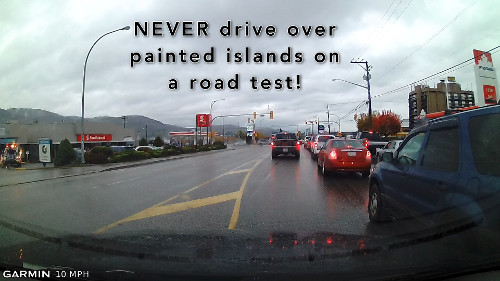
[DEEP INHALATION OF BREATH]
Because they...
you know - they're still sort of feeling out your driving ability.
So error on the side of caution.
Must Clear The Intersection
Now you can see this vehicle in front of me, he's right out in the intersection.
There's a an 18-wheeler coming through the intersection.
Now he's had to go on the red, so that's why I didn't move out there at all.
Because he was sitting out there, and I saw the traffic coming from the other side.
So that's the reason I didn't move out into the intersection.
It is better to wait for the advanced green the left turning signal.
Okay, both hands on the steering wheel, scanning for pedestrians over there.
I don't see any pedestrians on this turn.
So we're going to have the advanced green and we're going to go.
And we've got the advanced green - driving forward, looking, shoulder checking and driving into the lane.
Right signal right away.
Shoulder check again immediately before crossing the line.
Conclusion
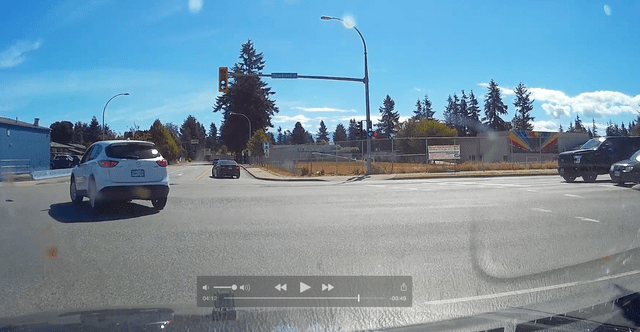 Quick review of left-hand turns.
Quick review of left-hand turns.
As you noticed in the footage I did a couple of the intersections more than once and the reason I did that is because traffic is dynamic its ever-changing.
And different vehicle configurations and the actions of drivers are going to change in the same intersection; therefore, it's important when you're doing your license and preparing for your license that you go out and practice the intersections around the licensing center.
That way you're going to be comfortable, or more comfortable, with the intersections in and around the licensing center and where you're going to be doing your test.
That way you're going to be familiar with complex intersections and how to do those.
Couple of points as well about left-hand turns.
When you do a left-hand turns on a multi-lane highways or multi-lane road--as you saw here in the city--in a couple of different places.
As soon as you make that left hand turn, immediately get back over to the right-hand lane.
Because you're going to be doing the speed limit - the posted speed limit.
For the purposes of your road test you're going to be traveling less than the traffic flow, so other traffic is wanting to get by you and they need to get by you in the passing lane because you're traveling less than the traffic flow.
Stay over to that right-hand lane and get over there immediately.
So as soon as you get around the corner and the vehicle straightens out in that left hand lane after making your left hand turn put your right hand signal on and do all of the steps for doing a correct lane merge.
| PASS YOUR DRIVER'S TEST WITH OUR COMPREHENSIVE CHECKLIST! |
And i'll put a video up here for you for the lane changing video and you can see that and figure out how to do that.
As well, I haven't gone over the steps of this because there's a video on left-hand turns and the theory of left-hand turns.
And again I'll put another card up here for you in the corner.
Make sure you check that out as well.
Last point on left-hand turns - if the way is blocked on the other side of the intersection because there's a large vehicle there, you may have to do that little jig jog.
And the reason you do the little jig jog is to to move the vehicle to the left so that you can see oncoming traffic, and see past that large obstruction.
And you need to straighten your wheels out.
And the reason you straighten your wheels out is in the event--the unlikely event--that you get rear-ended you're not going to be driven out into oncoming traffic.
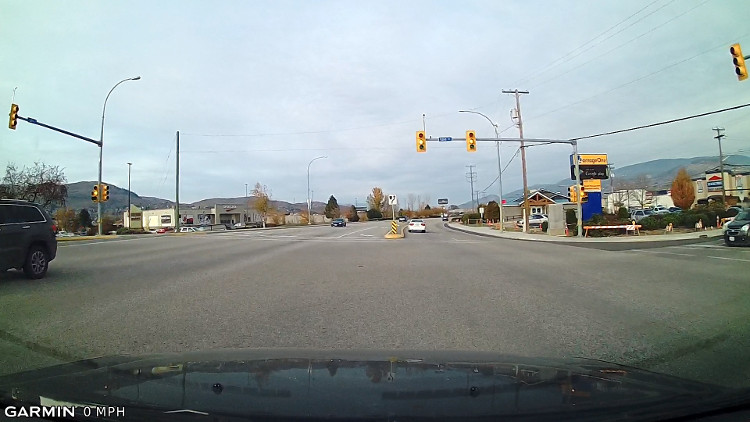
So that's the reason you do the little jig jog and get your wheels back to straight.
That way if you rear-ended you're going to be driven forward and only have one crash instead of two.
That's the reason for the jig jog for the purposes of your road test.
Question for my smart drivers:
Did you find that this video allowed you a better perspective of the intersection when you were watching the video and gave you more information about making left-hand turns?
Leave a comment down in the comment section there - all that helps us out.
I'm Rick with Smart Drive Test.
Thanks very much for watching.
If you like what you see here share, subscribe, leave a comment down in the comment section.
As well, hit that thumbs up button.
If you're working towards your license or a career as a bus or truck driver, make sure you check out all the videos on the channel.
Stick around to the end of the video they'll be end cards here that will give you suggestions for other videos to watch.
As well, head over to my website - lots of great information over there and online courses that you can purchase.
Thanks again for watching.
I'm Rick with Smart Drive Test.
Good luck on your road test.
And remember, pick the best answer not necessarily the right answer.
Have a great day.
Bye now!
Blooper
For the purposes of a licence exam, you must keep both hands on the steering wheel for the duration of the test.
[ENDCARDS & BLOOPER] Global news is out there shooting.
They have a really nice camera.
I've got camera envy now that I am shooting! [CHUCKLING]




